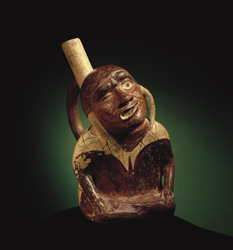Facial paralysis
| Facial nerve paralysis | |
|---|---|
 |
|
| Moche Culture Representation of Facial Paralysis. 300 A.D. Larco Museum Collection Lima, Peru. | |
| Classification and external resources | |
| Specialty | neurology |
| ICD-10 | G51 |
| ICD-9-CM | 351 |
| MedlinePlus | 003028 |
| eMedicine | plastic/522 |
| MeSH | D005158 |
Facial nerve paralysis is a common problem that involves the paralysis of any structures innervated by the facial nerve. The pathway of the facial nerve is long and relatively convoluted, and so there are a number of causes that may result in facial nerve paralysis. The most common is Bell's palsy, a disease of unknown cause that may only be diagnosed by exclusion.
Facial nerve paralysis may be divided into supranuclear and infranuclear lesions.
Central facial palsy can be caused by a lacunar infarct affecting fibers in the internal capsule going to the nucleus. The facial nucleus itself can be affected by infarcts of the pontine arteries. These are corticobulbar fibers travelling in internal capsule.
Infranuclear lesions refer to the majority of causes of facial palsy.
Facial nerve paralysis is characterised by unilateral facial weakness, with other symptoms including loss of taste, , and decreased salivation and tear secretion. Other signs may be linked to the cause of the paralysis, such as in the ear, which may occur if the facial palsy is due to shingles. Symptoms may develop over several hours. Acute facial pain radiating from the ear may precede the onset of other symptoms.
Bell's palsy is the most common cause of acute facial nerve paralysis. There is no known cause of Bell's palsy, although it has been associated with herpes simplex infection. Bell's palsy may develop over several days, and may last several months, in the majority of cases recovering spontaneously. It is typically diagnosed clinically, in patients with no risk factors for other causes, without vesicles in the ear, and with no other neurological signs. Recovery may be delayed in the elderly, or those with a complete paralysis. Bell's palsy is often treated with corticosteroids.
Reactivation of herpes zoster virus, as well as being associated with Bell's palsy, may also be a direct cause of facial nerve palsy. Reactivation of latent virus within the dorsal root ganglion of the facial nerve is associated with vesicles affecting the ear canal, and termed Ramsay Hunt syndrome type II. In addition to facial paralysis, symptoms may include ear pain and vesicles, sensorineural hearing loss, and vertigo. Management includes Antiviral drugs and oral steroids.
...
Wikipedia
